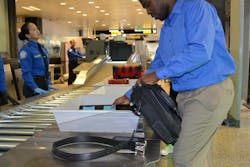While Seattle-Tacoma International Airport (SEA) keeps seeing more passengers flow through its facilities, limited terminal space created a major pinch point in traffic.
SEA installed three automated screening lanes (ASL) at the Transportation Security Administration (TSA) checkpoint at the north end of the terminal in March.
Lance Lyttle, managing director of SEA, said the airport invested in the system because it moves passengers through the checkpoint in a more efficient manner.
“We don’t have a lot of space to expand our security checkpoints, so we have to make it work as efficient as possible,” he said. “Over the years, we’ve done multiple things. We hired guest contract workers to help us during peak times, we’ve worked really closely with the TSA to get additional K9 units so we could get people through the checkpoints faster. This is an additional way that we’re looking to make our security checkpoint far more efficient than what we have now and far more secure.”
The ASL moves bins through X-ray machine tunnels and automatically divert baggage with prohibited items. Once the bins are emptied, they’re automatically transferred back to the start of the screening area so TSA officers don’t have to physically move them from the sterile side to non-sterile side.
SEA opted for the Vanderlande system and will have 14 total ASLs when the project is completed. It has budgeted $17 million for the project.
Lyttle said the airport led the design and construction of the ASLs and paid for the lanes. They worked with TSA and the airlines to make sure their needs were met with the upgrades.
The upgrade dropped the number of screening lanes at the checkpoint from seven to six.
“These lanes are efficient, but they require more space,” he said. “We had to do some really careful planning and we had to draw on the innovation of our designers to ensure we maximized the use of this space because we’re going to end up losing lanes in totality, but we gain efficiencies through the ASL lanes we have over the traditional lanes.”
Lyttle said he was comfortable with losing lanes because staff has done site visits to other airports with the equipment and see the efficiency gains.
“Some airports have reported a 30 percent increase in efficiency and throughput,” he said. “We think it’s really a wise investment.”
Lyttle recommended airports interested in ASLs should get all of the key stakeholders on board and to plan exactly how to fit the larger machines into the facility. He said it’s important to work closely with the vendor as well to make sure the equipment is working properly.
“Training is a key component,” he said. “You have to make sure you coordinate with the TSA so they can get their folks trained on how to use the automated screening lanes as opposed to the other lanes.
CT scanners ready for major deployment
The Transportation Security Administration (TSA) tested computer tomography (CT) scanners at checkpoints at Phoenix Sky Harbor International Airport (PHX) and Boston Logan International Airport (BOS) in 2017. American Airlines passengers at the airports took part in the test.
Mark Laustra, vice president of global development and government relations for Analogic Corp., said the tests show the viability of the technology at airports and the Trump Administration is now asking for more than $70 million to purchase 145 of the machines to deploy across the nation.
“When you look at the president’s budget last year, there were only two CT scanners in the budget in 2019. Now we have $74 million to buy about 150,” Laustra said. “That’s about half of what the TSA asked for, but it’s a huge increase from two.”
CT scanners provide a more detailed look inside baggage than traditional security checkpoint X-ray equipment. Laustra said it uses a complex algorithm to detect explosives, so passengers no longer need to take their electronics out of their baggage when in line, which in turn speeds up the screening process.
CT scanners are used in the medical field, but Laustra said Analogic developed a product shortly after 9/11 for airports to scan checked baggage for explosives. The devices have been used in this capacity for years, but are finally scaled down and ready for deployment at security checkpoints.
“We’ve seen a lot of traction in the last nine months and you’re going to see a lot more deployments this year. More trials and more deployments,” he said. “And you’re going to see a much larger deployment in 2019.
Laustra said Analogic did limited trials with a Cobra CT scanner in 2007 at airports across the world, but it wasn’t well received at that time.
“It was too large, too slow and it lacked the user interface and it was too expensive,” he said. “We took those lessons and we developed a product we call Connect.”
Laustra said Connect is two-thirds the size of the Cobra machines. It’s lighter, faster and utilizes a user interface similar to an iPad. Users can move the images around using just one finger and can zoom in by pinching the screen.
Analogic is trialing Connect at Amsterdam Airport Schiphol (AMS) and Tokyo Narita International Airport (NRT). AMS has exponential passenger growth with nowhere to add additional checkpoints, so CT scanners are seen as a viable solution. NRT is faced with the same issues coupled with an anticipated crush of passengers when it hosts the 2020 Summer Olympics.
Laustra said he was at NRT when the trail began. There was a learning curve the first day of operations, but by the second day of the trial, staff was processing passengers much faster than the old checkpoint configurations allowed.
“Because of the user interface being like an iPad and most people have experienced some type of tablet PC like an iPad, they got it pretty quickly,” he said. “There were no buttons to push. It was just a matter of using your finger to navigate around the screen and look underneath the bag for concealed threats.”
The scanners are machine-driven and go through a learning process as more baggage goes through the system, Laustra said, so it can learn more about nonthreatening materials
“I was in Narita when the trial started. The first day was a bit of a learning curve, but by the second day the trials were going very well,” Laustra said. “They were processing passengers at a much faster rate than the day before and much faster than with their previous checkpoint configuration.”
Automatic exits offer efficient flow out of the terminal
When leaders at Phoenix-Mesa Gateway Airport (AZA) in Mesa, Arizona found out the facility was going to see additional traffic coming in, they knew steps were necessary to keep on top of the passenger experience.
Passenger numbers have grown in recent years, but J. Brian O’Neill, executive director/CEO of the Phoenix-Mesa Gateway Airport Authority said Allegiant Airlines’ decision to add eight new destinations to AZA and WestJet’s move to expand its service meant more people will be flowing through the facility, so they needed to address how passengers move through security.
“If we were going to continue to be that convenient regional airport, we needed to really focus on enhancing capacity where we felt there could be potential chokepoints in the system,” O’Neill said. “We’ve done the roadway enhancements, parking lot enhancements and as we continue to grow, we’re really trying to stay ahead of the curve and address these infrastructure projects where we think that there’s an opportunity to add capacity and improve security and improve the customer experience.”
The first phase of the project involved expanding the passenger queuing area before reaching the security checkpoint. The second phase of the project expanded the security lanes from four to five, with space for a sixth lane from expanded passenger growth. The third phase installed an automated security lane for passenger leaning the sterile side of the terminal.
AZA handles about 1.4 million passengers per year. O’Neill said the security enhancements increased terminal capacity by about 1.8 million passengers per year.
“We’re very pleased,” O’Neill said. “We’re confident this enhanced the overall passenger experience.”
The entire project took about eight months to complete and cost $2.3 million. The automated security lane came on line in February. DWL Architects and DPR Construction were involved with the project.
The airport increased the queuing area by removing some offices it no longer used and reorganizing the existing footprint inside the terminal. They’re now advancing a project to install a canopy with air moving fans to connect the security area to the building where ticketing takes place.
Installing a dormakaba automated security exit lane to allows passengers to flow from the sterile side of security to the non-sterile side without needing additional staff to watch the area.
“Because our security exit lane wasn’t comingled with our TSA security screening checkpoint, the airport was responsible for allocating staff to sit there at the exit door to make sure there were no individuals trying to go through the wrong way and enter the airport without going through the TSA security checkpoint,” O’Neill said. “(I)t’s the first fully-automated security exit system in the southwest and we’re really excited about it.”
O’Neill said the timing was right to implement the automated security lane because the technology has matured into a proven system. AZA wanted to make sure the technology wouldn’t degrade the security posture at the airport. They found it enhanced security.
“If you were out here and you tried to go through these doors, you’d find it’s very, very, very challenging to make any headway going the opposite way,” he said. “And No. 2, we looked at it as a customer experience enhancement because there were times that we didn’t have flight activity where we would shut the exit door from the secure side of the terminal to the non-secure side of the terminal and people who had lingered in there after their flight or had gotten something to eat would have to track somebody down so that we could open the gate and allow them to go through.”
The system uses sensors to halt people from walking through the area, which O’Neill said staff can be reassigned to address other areas of the airport.
Since the system went on board, O’Neill said they haven’t seen anyone try to challenge the system and it has allowed for the free flow of passengers out of the secure side of the terminal.
“We see it as increased efficiency and we’re very pleased with how it’s functioning,” he said.
Crews working on the AZA project performed most of the work at night to avoid major disruptions for passengers. O’Neill said crews would entirely shut down the security area at night and reopen them in the morning. They created a temporary doorway for passengers while working on the automated security lane, so the area was walled off during construction and tested before opening to the public.
The sensors for the doorway are extremely sensitive and O’Neill said the airport wanted to have all of the construction dust removed and the area cleaned while calibrating and putting the machine online.
“The first thing you need to do is make sure you’ve got your construction project cleaned up, you got all the debris and construction dust removed before you start calibration,” he said. “It’s a very sensitive system.”
Bill Seibert, business development manager for airports solutions for dormakaba USA Inc., said automated security exit lanes are being embraced by airports in the U.S. because the technology has matured in recent years and federal officials propose cutting funds for staffing the lanes each of the last several years.
“It’s something that never sleeps. It monitors 24/7,” he said. “The sensors have advanced to the point where this technology is not from 2010. It is advanced enough to where airports feel comfortable.”
Seibert said automated lanes can be a valuable tool for airports of all sizes and can fit within most any access area. The only scenario they will not work in is a heavily sloped corridor, which he said no manufacturer makes a product to align sensors.
“All the airports can use it, from small to medium to large,” he said. “The range encompasses everybody. Small, medium and large are all looking at this technology.”
Seibert said airports looking at automated exit lanes need to understand the technology before making a decision. There are several manufacturers on the market and they use different technology and they should determine how it will impact airport operations, how it will incorporate into the access control system and what it will look like.
The airport should also look at yearly throughput today and what’s expected a decade down the road. When airport leaders understand what their needs will be, they can work with an architect to make it fit into the terminal.
“From there, it’s all about coordination,” Seibert said. “Pulling wires to where they need to be, making sure you have all the inputs and outputs that you want.”
Consultants integrating the lanes into a terminal should also consider how the lanes will fit into the landscape of the building.
Seibert said airports need to educate themselves on service plans for the lanes to keep the automated lanes operating properly.
“Look at if it’s a local person or do they have to fly in every time,” he said. “At dormakaba, we will go through a four hour training session just for the airport maintenance staff so they can do some light maintenance.”





